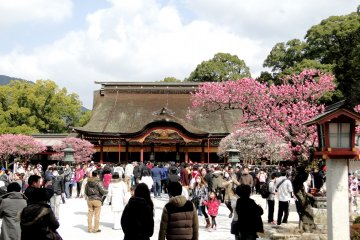
Floraison de Pruniers à Dazaifu
Mandy BartokLes pruniers en fleurs annoncent le début du printemps au sanctuaire Dazaifu Tenmangu dans la préfecture de Fukuoka.

Le sanctuaire Dazaifu Tenmangu est situé dans la ville du même nom, Dazaifu, sur l'île principale de Kyushu. Les sanctuaires Shinto Tenmangu sont tous dédiés à l'érudit Sugawara no Michizane qui a été élevé au rang de divinité de Tenjin. Le sanctuaire Dazaifu Tenmangu est l'un des trois plus importants du genre au Japon.
The shrine's honden (main hall) will undergo major renovation from May 2023 to 2026. During this period, the shrine will set up a unique temporary hall in front of the honden. This one-story building will feature trees and grass on the roof to harmonize with the encircling environment.
Le sanctuaire d'origine a probablement été construit en 905 sur la tombe de Michizane, décédé ici en exil, et a été agrandi au fil des ans par le clan Fujiwara. Après un incendie, le sanctuaire que l’on connait aujourd’hui a été construit en 1591 et est considéré comme un bien culturel important du Japon.
La superficie entière du sanctuaire s'étend sur plus de 12 km² et, la zone abrite également plus de 6000 pruniers japonais, ainsi qu'un certain nombre d'énormes camphriers, dont l’âge de certains est estimé à environ 1500 ans.
En raison de son dévouement à l’érudit Sugawara no Michizane, représentant parfaitement la sagesse, les gens viennent ici principalement pour prier afin d’obtenir de bons résultats aux examens et réussir dans leurs études.

Les pruniers en fleurs annoncent le début du printemps au sanctuaire Dazaifu Tenmangu dans la préfecture de Fukuoka.

The Komyozenji Temple in Kyoto is a Buddhist temple that was founded in 1273 by the Buddhist priest Tetsugyu Enshin. The temple is known for its rhododendrons, autumn leaves and Karesansui rock gardens and belongs to the Tofukuji school of Rinzai Zen Buddhism. In the Main hall is a statue of the Medicine Buddha Bhaisajyaguru. The main attraction of Komyozenji is its beautiful Japanese gardens. The temple has two rock gardens that visitors can admire. The smaller of the two gardens consists of fifteen rocks set amid raked pebbles. The rocks are distributed in such a way that they form the Japanese symbol for "" light "". The larger garden can be viewed from the main building of the temple. In addition to stones, it also houses some plants. The entire garden of the Komyozenji Temple is one of the most attractive temple gardens in Western Japan.

Fukuoka Hakatanomori Stadium, also known as Level 5 Stadium, has 22,500 seats, many of which are so close to the field that the audience really feels they are part of the action. A practical factor is the stadium's proximity to Fukuoka International Airport, which is only a 15-20 minute walk away. Both football and rugby matches are regularly held at Fukuoka Hakatanomori Stadium. Games were also played here during the 2019 Rugby World Cup. The stadium is located in Higashi HiraoPark, which includes a baseball and tennis facility, an athletics stadium and the "Accion Fukuoka", which consists of a hall and a swimming stadium.
